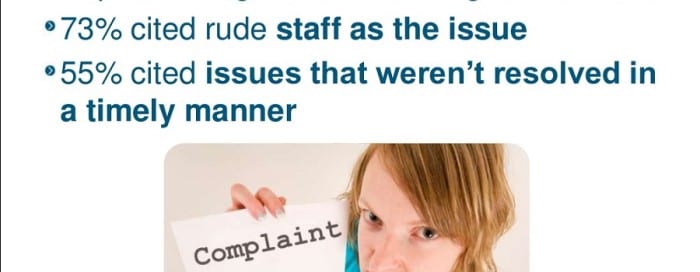Customer Satisfaction: What you think they want Vs. What They Really Want

Table of contents
Are you well acquainted with customer psychology?
If someone gives you an impromptu business quiz about what makes customers tick, would you pass it with a score you can be proud of? Here at GrexIt we want to help you get the highest possible score. It’s a given — every business owner would like to see happy customers. Wouldn’t you? I can see you nodding, there. After all, happy and satisfied customers would surely mean more profits for your company.
Furthermore, we would like to help you win in this hyper-sensitive area of running a business, so we have gathered some critical misconceptions that business owners have about customers, and the things you can do to correct them.
You see, as much as business owners would like to believe that they have figured out their customers, research have shown that there’s a big gap between businesses’ perceptions and the real sentiments of customers. Look below. Is any of these misconceptions present in your company?
Business owners: Regarding customer service, the quicker the better.
Customers: Quick is good, but we are more concerned about the attitude of the staff and the quality of service.
Studies have shown that quality service always outweighs speed. Just recently, Gallup consultants found, in a study done for one of their banking clients, that “customer perceptions of the tellers’ courtesy and their apparent willingness to help were far more important than speedy service in generating customer engagement. Customers who gave the bank high ratings on those “people” attributes were nine times more likely to be fully engaged.” And product knowledge and associate sincerity, compared to fast service, perform much bigger roles in customer engagement.
Additionally, the Customer Experience Impact Report by RightNow resulted in findings that say when customers were asked why they stopped patronizing a company, sluggish customer service only comes in second compared to rude staff which is on the top spot. This indicates that most customers put more value on attitude and quality than speed.
Now don’t get me wrong, there’s absolutely nothing wrong with desiring to fix your customers’ problems as fast as you can. Just make sure you don’t sacrifice the quality of service for it. If you need more time to reassure a caller or really need to expound on a delicate issue, then go for it.
How to correct it ⇒ Make providing value your core, be thorough, and be effective in engaging your customers. They can tell whether a company is working to help them with a genuine intent or not. They can also tell if the company is just working for a way to push them out the door as fast as possible.
Photo Credit: Right Now
One of the most common presumptions of business organizations is that disappointed customers will always air their grievances or dissatisfactions. On the contrary, according to John Goodman, Salesforce.com Vice President & Chairman of Customer Care Management & Consulting, a lot of companies believe that when complaints become less… …satisfaction levels increase. However, that’s commonly not the case. In his post on Forbes.com, he further states “…not even 25% of customers bring their service issues forward because it’s often just too much hassle. Many of them still believe companies won’t care and/or won’t fix the problem to their satisfaction, even if they did receive their complaint.”
How to correct it⇒ Correct this by letting customers know that you’re addressing their concerns and by following up on them.
Let’s say a customer complains that they could not locate a particular button on your site. Go the extra mile and show your customer exactly where it is by email or by chatting with them online or on the phone. Other companies will just take note of it. Set yourself apart by going above and beyond what they can do.
Demonstrate that you are doing your best to assist them and after fixing their problem, make sure to contact them and ask if everything’s okay. If they still need some help, make sure to continue assisting them.
Showing them that you intentionally seek for their feedback and that you’re proactively addressing their needs will make them feel good about communicating with you.
Business owners: Good customer service is the primary reason customers communicate with brands on social media.
Customers: Customer service is one reason, but we connect with brands on social media primarily for the rewards, rare deals, and exclusive content.
In a recent Pivot research, the company’s findings show that there is a big difference between the marketers’ perception and the way customers see things when using social media. According to the Pivot research, “When Social Consumers were asked what they want from Social engagement, their desires were clear: deals, special content and rewards based on their engagement. Customer service ranks dead last in their responses. When Social Marketers were asked the same question, they indicated customer service as the benefit they felt Social Consumers wanted most.”
Let’s be clear about one thing, this does not signify that customer service through the social media platform is not potent. Although, it’s clear, based on the study by Pivot, it’s not the main reason why people use it.
How to correct it ⇒ So while it’s important that your social media managers are alert to answer questions and address customer concerns, it’s also a good piece of advice to emphasize that their function also includes other tasks. Reiterate that they are engaged with customers to provide invaluable content, unleash exclusive deals, and your brand’s followers some great rewards.
Business owners: Customers’ only concern is to make sure they can grab some benefits from our products or services. They don’t care about other customers.
Customers: We are concerned about our peers and we are willing to help business owners improve their product and services if we’re given the chance.
There are certain things that customers are much better in compared to business owners. One of them is — customers know and understand the needs of their peers. Studies show that customers “do” know what they want in numerous situations.
One instance we can confirm this is a study done by the Institute of Management Sciences led by Eric von Hippel of MIT. It portrayed an interesting picture about the importance of customer input in many businesses’ victories.
The crucial findings of the study were:
- Based on a study of 1,193 commercially successful innovations from nine industries, (60%) 737 came from customers (this number shows that customers can come up with extremely innovative ideas).
- Innovations of users (customers) have been successfully used to turn around “innovative slump periods.”
One unique case study for #2 that really demonstrates a believable scenario where customer input is invaluable comes from 3M (a big conglomerate). The poorly performing Medical-Surgical Markets Division of 3M was, at the time, looking for a way to rev up its lackluster innovation record. This was during the 90s.
Veering away from the standard routine which is relying on employee-backed ideas, another group (consisted of “lead users”: customers) was organized by the company to discover breakthrough innovation.
When results of these two groups (users vs. employees) came out and were compared side-by-side to find out revenues generated, the differences were quite unexpected and unbelievably huge:
- innovations made by lead users had a median revenue of $146 million (in 5 years).
- employee-led generated innovations had an average revenue of $18 million (in 5 years).
Results: Customers came up with better ideas more often.
Based on this study, we strongly suggest that in your business, you use your customers’ potential to the utmost. The truth is, we want you to make sure of this. And don’t forget, Customer surveys and studying and analyzing feedback from customers should be an integral part of your research.
Business owners: It’s not good advice to label customers.
Customers: We like being labeled and we are more inclined to participate if we feel we are included.
We are actually suggesting that you label your customers. It may sound like bad advice, but it’s one that is based on a well-conducted study. ~ Source: Motivating voter turnout by invoking the self.
Let me tell you about the results of the study courtesy of Help Scout below:
We’re not talking about brand labels here. Contrary to popular belief, research show that people actually like being labeled. They are more motivated to participate if they feel included in a group.
In the study, 50 percent of the participants were not informed about anything; the researchers just asked them to describe voting patterns they go through. Furthermore, they observed voting patterns of 133 adults in order to check if labeling these people had any substantial effect on the turnout at the polls.
After casual questions were asked about their regular voting patterns, 50 percent of the participants were informed that they were much more likely to vote because they had been told by the social scientists to be more politically active. (Can we keep this between us — this isn’t true; the participants were randomly selected.)
In spite of the fact that it was a random selection, the participants who were told they were “politically active” had a 15% higher turnout compared to the other group. Fifteen percent is no joke!
The human brain seeks to have a sense of consistency (albeit artificial),and that’s why the foot-in-the-door technique works so well even on prepared minds. We enjoy being consistent so much so that even being told we are a member of a class or say — a group, makes us more open to its message, as long as it’s something we agree with (like being called a responsible voter). This is mainly the reason why “Gold” or “Platinum” status works for a customer loyalty program, effectively.
People who are labeled as “superior” consumers tend to buy more, and those in the “regular” class most of the time are not affected.
How to correct it ⇒ Don’t be scared to label your customers. Generally, people like being a member of classes implying a form of superior quality or level of status that they approve of. Even if the reason is artificial, people tend to act accordingly in order to feel they belong to an “elite” level. ~ Source: Motivating Voter Turnout by Invoking the Self
How to do your homework properly ⇒ Probe, Listen, and Modify
When we talk about probing, the fact of the matter is… do we care enough to really try to get to the bottom of things? Do we seek to understand the importance of research? This simply means not only doing your homework thoroughly, but doing it in advance. You should also solicit feedback as you go along. After those are done, it’s time to adapt. And finally, modify based on feedbacks gathered and from the results of your study.
What specific things can you do:
You can observe your target audience’s preferences via buyer persona work at the onset. You can also conduct surveys. Do some polls. Solicit thoughts and opinions on ways to improve your product or service. Gather post-sale feedback. Get customer reviews. Unleash a system using ongoing email that mainly addresses post-sale. Lastly, you can organize fun events for your customers.
In this stage of your business, do you still have some presumptions about your customers that ultimately turned out to be untrue? Please feel free to tell us about them. You can share your thoughts in the comments area below.


































